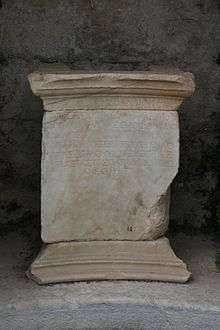Definify.com
Webster 1913 Edition
Plinth
Plinth
,Noun.
[L.
plinthus
, Gr. [GREEK] a brick or tile, a plinth, perh. akin to E. flint
: cf. F. plinthe
.] (Arch.)
In classical architecture, a vertically faced member immediately below the circular base of a column; also, the lowest member of a pedestal; hence, in general, the lowest member of a base; a sub-base; a block upon which the moldings of an architrave or trim are stopped at the bottom. See Illust. of
Column
. Webster 1828 Edition
Plinth
PLINTH
,Noun.
In architecture, a flat square member in form of a brick, which serves as the foundation of a column; being the flat square table under the molding of the base and pedestal, at the bottom of the order. Vitruvius gives the name to the abacus or upper part of the Tuscan order, from its resemblance to the plinth.
Plinth of a statue, is a base, flat, round or square.
Plinth of a wall, two or three rows of bricks advanced from the wall in form of a platband; and in general, any flat high molding that serves in a front wall to mark the floors, to sustain the eaves of a wall or the larmier of a chimney.
Definition 2025
plinth
plinth
English
Noun

A Plinth.
plinth (plural plinths)
- A block or slab upon which a column, pedestal, statue or other structure is based.
- 1963, Margery Allingham, “Foreword”, in The China Governess:
- He turned back to the scene before him and the enormous new block of council dwellings. The design was some way after Corbusier but the block was built up on plinths and resembled an Atlantic liner swimming diagonally across the site.
-
- The bottom course of stones or bricks supporting a wall.
- A base or pedestal beneath a cabinet.
Translations
base for column, pedestal or statue
bottom course of stones supporting a wall